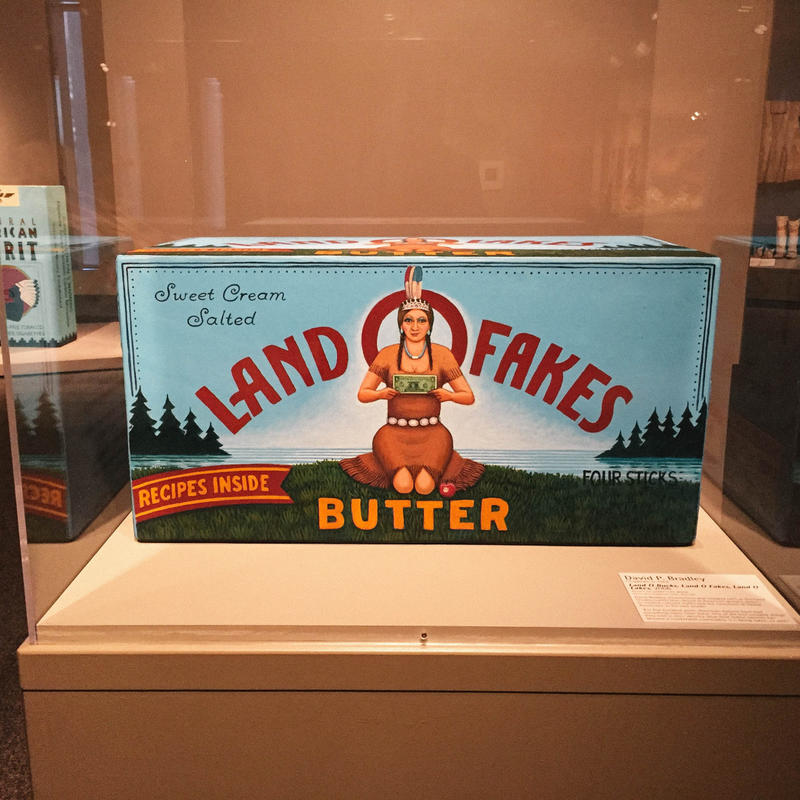More about Land O Bucks, Land O Fakes, Land O Lakes

Sr. Contributor
David Bradley is a member of the Chippewa Tribe in Minnesota, where he grew up, although he now spends his time in Santa Fe, New Mexico.
Minnesota, uncoincidentally, is also the “Land of 10,000 Lakes,” and the home of the Land O’ Lakes dairy products company. Bradley creates art that tells a narrative, most often with through the lens of Native American social justice, and the sculpture Land O Bucks, Land O Fakes, Land O Lakes, is no different.
In the collection of the Denver Art Museum, Land O Bucks addresses the commercialism and commodification of the American Indian, and their art, that has taken place for decades. In this case, it is a Native American woman on the original Land O’ Lakes packaging that is the face of that commodification. The face displayed on the packaging even had a name, “Mia,” and Mia has been used as the face of the Land O’ Lakes products since 1928. Not only was she on the butter package, but also cream, cheese, milk, and eggs, pretty much everything the company makes.
However, in 2020, the use of an ethnic stereotype is not just a bad idea morally speaking, it’s also bad for business. The Land O’ Lakes company announced that they will no longer be using a Native woman as their logo; the packaging will instead show a serene lake surrounded by trees. Other companies have also realized this; for example, Eskimo Pie will soon be named Edy’s Pie (one of the company founders), and Aunt Jemima, the brand with the stereotypical "Mammy" character of the same name who once appeared on pancake mix and syrups, is now the Pearl Milling Company. Interestingly, the current version of the woman on the packaging was designed by a Red Lake Ojibwe Nation commercial artist by the name of Patrick DesJarlait, when the logo was updated in the 1950s. In his art, DesJarlait’s goal was to create positive images of Indians, and to “remind my people of their own heritage.”
Bradley has often used pop art styles in his work, and Land O Bucks is reminiscent of Andy Warhol’s Campbell’s soup cans and Brillo boxes. Bradley, however, takes it a step or two further, not only replicating the design of the Land O’ Lakes box, but reimagining it to make his point. In his version, the Indian woman is showing some cleavage (because sex sells, right?), and is holding a dollar bill instead of the box of butter. The apple with a bite out of it may be a reference to temptation, but it’s unknown if Bradley has spoken to this detail.
It is not clear if the woman on the Land O Bucks, Land O Fakes, Land O Lakes label is supposed to be a Native American woman or a white woman dressed an Indian costume. Bradley’s version wears heavy make-up, modern jewelry and a diamond tiara, while the original version wears traditional beaded adornments. It’s easy to see that Bradley’s is meant to convey a less wholesome image than the original.
This would not be the last time Bradley used the Land O’ Lakes brand in his art; in 2007 he painted Land O’ Fakes (Museum Currency), which is a much more biting commentary referring to fraud in the Native American art market, particularly in Santa Fe. This issue was very personal for him, (the painting remains in his own collection) as there was a problem with non-Native artists selling their work as “Indian art.” Bradley spoke out about this, and was part of a group that helped to get the Indian Arts and Crafts Act passed. For his trouble, he was blacklisted by some galleries, curators, and even other artists; this apparently went on for several years and is explicitly referenced in that painting.
Sources
- Brockman, Joshua. “A New Dawn for Museums of Native American Art.” The New York Times. The New York Times, August 20, 2005. https://www.nytimes.com/2005/08/20/arts/design/a-new-dawn-for-museums-o….
- Jtraberg, /. “Native Americans, Butter, and the White Man.” A Scandinavian take on Colorado, October 6, 2014. https://scandinavianlense.wordpress.com/2014/10/06/native-americans-but….
- Peiper-Riegraf, Dorothee. “Riegraf Collection, Native American Art, Native American Artists, Modernism, Native Postmodernism, Native Modernism.” Peiper. http://www.peiper-riegraf-collection.com/peiperhtml/e-02-01-00-artists_….
- Valinsky, Jordan. “Eskimo Pie Is Getting Rid of Its Derogatory Name.” CNN. Cable News Network, October 6, 2020. https://www.cnn.com/2020/10/06/business/eskimo-pie-name-change/index.ht….
- Verzuh, Valerie K., Suzan Shown Harjo, and David Bradley. Indian Country: The Art of David Bradley. Santa Fe: Museum of New Mexico Press, 2015.
- Wu, Katherine J. “Land O'Lakes Drops the Iconic Logo of an Indigenous Woman from Its Branding.” Smithsonian.com. Smithsonian Institution, April 28, 2020. https://www.smithsonianmag.com/smart-news/mia-land-olakes-iconic-indige…











